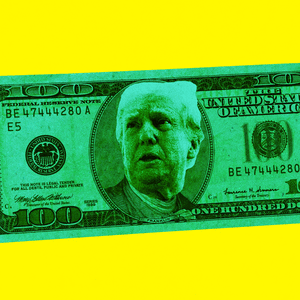During the midterm campaign, Republican strategists blamed another round of subpar small-dollar campaign contributions on a familiar culprit: inflation.
“It’s gas or this donation; it’s vacation with our children or this donation,” Zac Moffatt, CEO of top GOP fundraising firm Targeted Victory, said in July.
That might have been true for some. But according to a new The Daily Beast analysis of donor data, the Republican fundraising base this year actually skews a bit wealthier than that of Democrats.
Not only does that finding undercut the fundraising excuse, it also complicates the GOP’s attempt to rebrand as the party of the working and middle class—and to cast Democrats as the party of the wealthy elite of cities and suburbs.
The Daily Beast performed the analysis in partnership with artificial intelligence analytics firm Sterling Data Company, which has worked with about 1,000 Democratic political clients across the country.
Donor information was sourced from Federal Election Commission filings for the Republican and Democratic small-dollar fundraising mega-platforms WinRed and ActBlue, covering the final three and a half months before the 2022 election.
From those extensive lists, Sterling randomly sampled 50,000 contributors to each party, then cross-checked that information against the firm’s trove of public and private data to calculate average age, household income, and urban-rural spread.
The results give Republican small-dollar donors a slightly higher average (mean) annual household income—$50,849—about $1,000 more than their Democratic counterparts, who clocked in at $49,747.
Notably, the median household income for donors to both parties, a flat $55,000, is about $15,000 below the national median, which in 2021 was $70,784, according to U.S. Census data. This suggests that—aside from the ultra-wealthy megadonors who fuel super PACs and dark money organizations, largely beyond the scope of the data reviewed for this article—grassroots political fundraising overall is largely fueled by people who aren’t as wealthy as the average American.

A man distributes fake cash illustrated with former President Donald Trump.
Mark Makela/GettyAnd while those megadonors could make the income analysis “prone to outliers,” they comprise a minuscule number of donors and did not exert a pull in this small-dollar study, according to Sterling Data CEO Martin Kurucz.
The fact that Republican small-dollar donors on average make a little more money than their Democratic counterparts suggests that, when it comes to funding party politics, the GOP does not have the working class dominance it likes to project.
When it comes to votes, it’s more nuanced. And that’s largely a function of race—whether “working class voters” really means “white working class voters.”
Last month, The New Republic reported that Democrats got about 43 percent of the “non college” demographic—often used as a stand-in metric for working class support—which was a significant slip from the 49 and 48 percent they earned in 2018 and 2020, respectively. Republicans, however, saw that support grow from about 50 percent to 55 percent. In 2022, Republicans had their strongest performance among non-college educated voters since 2016, the year Donald Trump’s election shook up conventional wisdom about class politics.
The report attributed that to a partisan shift in nonwhite working-class voters, which “probably reflects mainly a shift among working-class Latinos” who broke for Republicans more than in previous elections.
However, The New Republic also noted that midterm exit polls showed Democrats took a majority of 52 percent of voters from households earning $52,000 or less. But in the $55,000 to $99,000 bracket, Democratic support dropped to a minority of 45 percent, with the $100,000+ bracket registering 46 percent. Those variations among professional classes are also reflected in the data.
Donors are required to list their occupation and employer, including retirees and those who are self-employed. Beyond retirees, which topped both party lists, the most common occupation among Democratic donors was a working-class profession—“teacher,” at about 3 percent. But attorneys, largely an affluent professional class, came in third.
Teachers were 10th among Republican donors. And job descriptions of sales, engineer, owner, manager, and physician all came in above lawyers.
But despite winning a higher percentage of higher earners at the voting booth, Republicans pulled in less money than Democrats for that same midterm election. Democratic candidates in critical races outraised Republicans nearly two-to-one, according to the Associated Press, sparking months of finger-pointing within the GOP over who and what is responsible.
Combined with the demographic analysis, that undercuts protestations from Republicans who, over the summer, attributed the Republican fundraising slump to economic conditions.
Given the fact that 50,000 random Republican donors on average made more money than 50,000 random Democratic donors, it would appear that something other than the economy was to blame.
Notably, then, the “retiree” demographic dominates both parties. However, it also skews heavily Republican: a majority of the GOP donors self-identified as retired, about 65 percent. Among Democrats, it was a far lower minority, around 39 percent.
That gets at the heart of a fundraising controversy—the exploitation of recurring donations, which is not only criticized as unethical, but has been thought to harm fundraising among Republicans, and Trump, in particular.

A volunteer collects donations at a golf cart parade to show support for U.S. President Donald Trump.
Paul Hennessy/SOPA Images/LightRocket via Getty ImagesThat issue came front and center after the 2020 elections, when some older donors began to complain about misleading pre-checked options on fundraising solicitations, which authorized automatic monthly withdrawals.
Both parties used the tactic, though it was more prevalent with WinRed than ActBlue. Critics say the practice exploits older, less tech savvy donors who had not known they were authorizing repeat withdrawals. Last year, reporting from The New York Times led attorneys general from four states to open investigations into the practice, with the state of Minnesota currently suing WinRed in civil court.
At the time, The Times analyzed the ages of donors who got refunds, on the theory that it would reflect people who may have signed up for recurring donations until they cracked the federal maximum limit. The study found that the Trump apparatus “refunded far more money to online donors in the last election cycle than every federal Democratic candidate and committee in the country combined.”
In that spirit, The Daily Beast separately analyzed people who gave to Trump’s Save America leadership PAC over the final three months of the midterms. We found that those donors tended to skew even older and more rural than the general WinRed donor.
Most tellingly, the Trump donors who got refunds tended to be older still. That’s a “giant red flag,” according to Josh Nelson, longtime progressive strategist and CEO of grassroots fundraising firm CivicShout, who decried the practice as “unethical and shameful.”
“Big picture, this data confirms what many of us have long suspected: Trump’s online fundraising program relies heavily on scamming senior citizens into signing up for inadvertent repeat donations,” Nelson told The Daily Beast. “Sadly, those donations are then charged to their credit cards each month indefinitely until they realize what is happening and demand refunds.”
But another warning flag about the transparency of GOP fundraising might lurk in the data, because WinRed’s data is less complete about who is giving the money.
The second most popular occupation among WinRed donors was “information requested”—meaning 1.85 percent of those donors did not, for whatever reason, give the information required of them.
For Democrats, that response wasn’t in the top 20.










